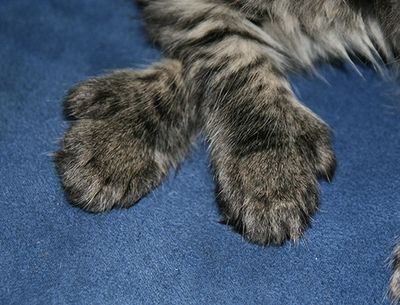Research
Over time, more and more has been discovered about the specific mechanisms of the genetics of polydactyly and yet more remains to be revealed. In 2008, Lettice, et al, reported in a ground breaking study that the polydactyl trait in cats is not actually due to a “polydactyl” gene, but rather to a single point mutation of the regulatory element responsible for expression of the gene that determines digit formation (see specifics below). Hamelin, et al, (2011) described 3 variations of this mechanism but also confirmed that an unknown alternate existed for a particular line originating in Canada. Several more recent publications documented the variability of phenotype – genotype. From the earliest publications to the latest, no detrimental effect of polydactyly has been apparent in the studied cats.

2020, Alexia Hamelin et al.
2017, Axel Lange, Gerd B. Müller – Department of Theoretical Biology, University of Vienna Polydactyly in development, inheritance, and evolution
2016, Alexia Hamelin, Dominique Begon, Fabrice Conchou, Marion Fusellier and Marie Abitbol.
Clinical characterisation of polydactyly in Maine Coon cats.
2014, Litter & Breeder tracker - database service
2013, Axel Lange, Hans L. Nemeschkal, Gerd B. Müller – Department of Theoretical Biology, University of Vienna. Biased Polyphenism in Polydactylous Cats Carrying a Single Point Mutation: The Hemingway Model for Digit Novelty
2011, Alexia Hamelin: La Polydactylie du Maine Coon – École Nationale Vétérinaire d’Alfort.
2008, Laura A. Lettice, Alison E. Hill, Paul S. Devenney and Robert E. Hill from the MRC-Human Genetics Unit, Western General Hospital in Edinburgh U.K.
Copyright © 2020 - 2024 MCPolydactyl - All Rights Reserved. Disclaimer